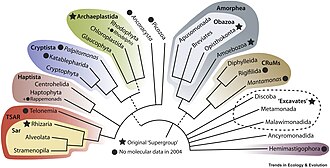Supergroup (biology)
A supergroup, in
share one common ancestor and have important defining characteristics. It is an informal, mostly arbitrary rank in biological taxonomy that is often greater than phylum or kingdom, although some supergroups are also treated as phyla.[1]
Eukaryotic supergroups
Since the decade of 2000's, the
paraphyletic or lacked defining morphological characteristics that unite their members, which makes the 'supergroup' label more arbitrary.[1]

Currently, the addition of many lineages of newly discovered
phylogenomic analyses have brought a new, more accurate supergroup model. These are the current supergroups of eukaryotes:[1]
- dinoflagellates, seaweeds, ciliates, foraminiferans, radiolarians, and the apicomplexan and oomycete parasites.[1] It essentially contains the majority of "Chromalveolata".
- Haptista (also treated as a phylum), previously in "Chromalveolata", comprising the haptophyte algae and centrohelids.
- Palpitomonas.
- Glaucophyta and Rhodelphis.
- apusomonads, and together form the clade Obazoa.
- Mantamonas.
- Jakobida and Tsukubamonas. It is the biggest remaining clade of the "Excavates".
- protists.
- Hemimastigophora, previously an orphan clade but recently brought into Diaphoretickes.[4]
- Provora, the most recent supergroup, containing the previously orphan Ancoracysta.[4]
Many orphan groups of free-living protozoa remain left behind, unable to be added to a supergroup, such as:
Apusomonadida, etc.[1]
A possible modern topology of the eToL would be the following (supergroups labeled in bold):[5][4]
Eukaryota
|
|
Prokaryotic supergroups
The term 'supergroup' is used in
phylogenetic studies of bacteria, in a smaller sense than within eukaryotes. As of 2021, it is very commonly used for naming clades within the genus Wolbachia.[6][7][8]
